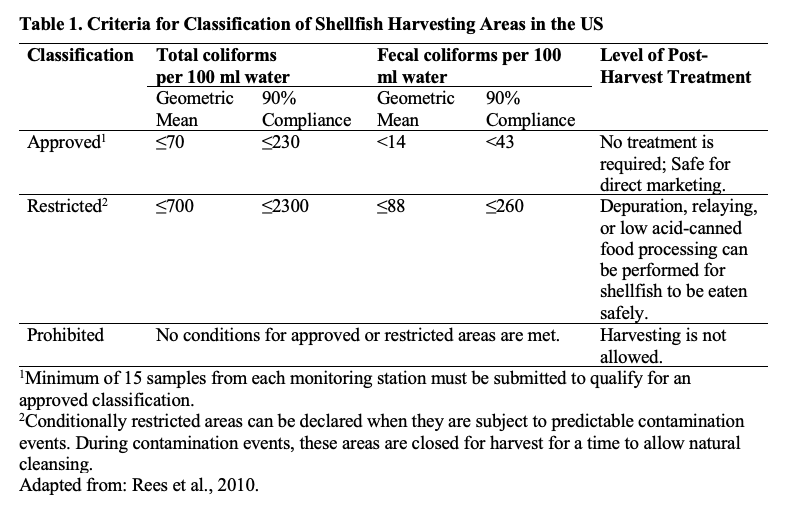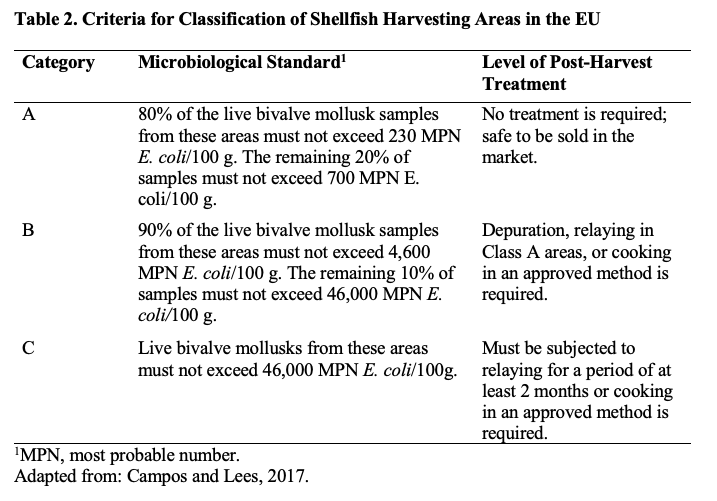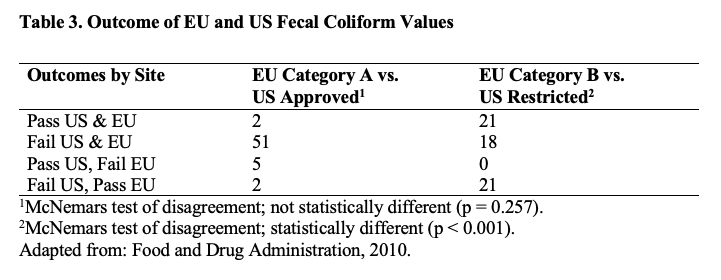One Health Newsletter
Shellfish Trade Concerns of the United States and the European Union: Determination of Equivalence in Sanitary and Phytosanitary Measures
Author
Toni Rose M. Barroga, D.V.M., MPH
Seafood Consumption and Trade of Agricultural Goods
The increasing global population, growing public awareness of health consciousness, and rising interest in reducing meat consumption to lower greenhouse gas emissions have all contributed to the search for alternative healthy food options.1,2 Seafood is becoming one of the healthier food choices because of its high nutritional components, such as high-quality proteins, polyunsaturated fatty acids, and other vitamins and minerals. Globally, the consumption of seafood products has increased more than twice (to about 20.5 kg per capita) over the past 50 years.3,4 However, despite the associated health benefits, seafood is also linked to numerous food-borne illnesses. For example, in the United States (US), the Centers for Disease Control and Prevention (CDC) revealed that seafood was responsible for 188 outbreaks resulting in 4,020 illnesses, 161 hospitalizations, and 11 deaths over the past 30 years.5,6
The consumption of shellfish, a term commonly used for crustaceans and mollusks, has increased due to the growing demand for marine products like bivalve mollusks.7 These mollusks, which are filter feeders that feed on plankton and organic matter in the water, are valuable but can pose health risks.8 They can accumulate water pollutants, including pathogens, making them a potential source of food-borne illnesses, like norovirus infection or hepatitis A.9,10 To minimize such risks, biological control measures and laws have been set up in many countries to ensure shellfish are farmed in low-pollution areas.11 Additionally, processes, like relaying and depuration, are used to clean shellfish to reduce the risk of consumption-associated infections.7,12 Relaying is the movement of shellfish from areas where the harvest is not permitted into a shellfish growing area classified as either approved or conditionally approved, whereas depuration involves placing the harvested shellfish into tanks of high-quality water so they will purge any contaminants stored in their gastrointestinal tract.
The globalization of food has opened the door to a wide variety of culinary ingredients in supermarkets worldwide, facilitated by trade agreements between countries and reduced taxes on products.13 The trade of agricultural goods between countries requires mutually agreed food safety standards or sanitary and phytosanitary (SPS) measures. While each country may implement these measures differently, establishing equivalence allows nations to recognize that their respective levels of protection achieve the same overall food safety objectives to protect consumers, facilitating smoother trade relations. These SPS measures are regulations, requirements, and procedures implemented to ensure food safety.14 Sanitary measures refer to those related to people and animals, while phytosanitary measures that pertain to plants and plant products are called phytosanitary measures.15,16
This paper highlights the process undertaken by the European Union (EU) and the US to establish equivalence on the determination of shellfish safety despite having two different sets of standards.

Image source: Pexels.com
Establishing Regulations in the Trade of Bivalve Shellfish in the European Union and United States of America
Different countries often impose different sets of standards to ensure the safety of shellfish consumption to the public. The most common method used to assess the presence of microbial contamination is by measuring fecal coliforms, such as Escherichia coli (E. coli). Harvesting areas of shellfish are classified based on the detection of E. coli. Classification allows the farmers to harvest the product or undergo further treatment before selling the product to consumers.17
The US and EU have different systems for classifying shellfish harvesting areas. The US surveys water samples from surrounding water and measures its fecal coliform levels, while the EU acquires samples of shellfish meat and quantifies the most probable number (MPN) of E. coli contamination.18,19 Tables 1 and 2 provide an overview of the criteria for classification of shellfish harvesting areas in the US and EU, respectively.17,20


Equivalence Determination of Shellfish Safety between EU and US
In the context of international trade, the term “equivalence” is defined as “governments recognizing other countries' SPS measures as acceptable even if they are different from their own, so long as an equivalent level of protection is provided.”14 The World Trade Organization (WTO) requires Member States (MS) to engage in technical consultation on a measure related to a product or category of products. This includes the evaluation of country regulations, approval or certification policies, and risk assessment to provide technical justification for the proposed SPS measure.21,22
In 1988, a Veterinary Equivalency Agreement (VEA) between the EU and the US was issued, which aimed to establish equivalence in different veterinary requirements of food animal origin (including shellfish).23 In 2008, the Directorate General for Health and Food Safety of the EU requested the US Food and Drug Administration (FDA) to enter an equivalence determination to allow the EU to export shellfish to the US. The findings of the assessment showed that the regulations were not equivalent due to the different methods for classifying shellfish harvesting areas, thereby halting the trade of shellfish between both countries in 2010. Since 2010, both countries have agreed to cooperate on technical consultations, guideline revisions, and on-site audits of experts.22
Assessment of Shellfish Harvesting Areas
In the US, aside from testing fecal coliform levels in shellfish harvesting areas, extensive sanitary surveys have also been performed, which report all environmental factors that can affect the water quality of the harvesting areas. In contrast, the EU uses only shellfish meat to determine the levels of E. coli. To address this gap, the EU issued two new guidelines entitled Community Guide to the Principles of Good Practice for the Microbiological Classification and Monitoring of Bivalve Mollusk Production and Relaying Areas with Regard to Regulation 854/2004 and Microbiological Monitoring of Bivalve Mollusks Harvesting Areas Guide to Good Practice: Technical Application, which provide overviews of how sanitary surveys should be implemented.20,24 Both countries agreed that these documents provide additional controls for the consumers, especially for farms exporting shellfish to the US.24
Microbiological Testing Using Different Methods to Evaluate Shellfish Harvesting Area Safety
To establish equivalence between the two approaches for classification in determining shellfish safety (water samples vs. shellfish meat), the FDA released an initial analysis to compare the microbiological standards in classifying the harvesting areas of both countries.25 The FDA compared the pattern of site-level compliance of both approaches for shellfish safety using McNemar’s test, a statistical test that determines if there is a difference between two related groups on a dichotomous dependent variable.26 Two sets of data were compared: (1) data from the EU shellfish category A versus US water criteria for Approved areas and (2) data from EU shellfish category B versus US water criteria for Restricted areas.
Before this document was released, they assumed that there was a 1:1 ratio of fecal coliforms and E. coli levels in shellfish and water. However, after some studies were conducted, particularly with oysters, they determined that the fecal coliform count and E. coli levels in shellfish meat are often different. Further analysis allowed them to quantify the count of E. coli bacteria by using the following calculation, where the number of fecal coliforms x 0.767 = E. coli count.
Using the equivalent fecal coliform levels from the analysis mentioned above, sixty different shellfish harvest areas were used to compare sites. Only sites with 10 or more observations for measurements of water- and shellfish-levels of E. coli were used in the analysis. The study used a pass/fail scenario for each sampling site based on the following criteria:
- EU Category A is 95% of shellfish have fecal coliform levels <300/100g, whereas the US Approved equivalent is geometric mean <14 fecal coliforms/100 ml, and the 90th percentile is <43 fecal coliforms/100 ml.
- EU Category B is 90% of shellfish have fecal coliform levels <6,000/100g, whereas the US Restricted equivalent is geometric mean <88 fecal coliforms/100 ml, and the 90th percentile is <260 fecal coliforms/100 ml.
The site-by-site comparison showed that the EU Category A and US Approved areas have no statistically significant level of disagreement (p=0.257) between the pass/fail outcomes, meaning that there are no disagreements between samples classified as either EU Category A or US Approved areas. In contrast, there was a statistical level of disagreement found for the outcomes of EU Category B and US Restricted areas (p<0.001). Table 3 shows the outcomes of using the pass/fail scenario of both sets of categories.25

On-site Evaluation of EU Food Safety Control System for Shellfish and Shellfish Trade Resumption
In 2015, US authorities conducted an on-site audit in Spain and the Netherlands, as these countries had adopted the previously mentioned Community and Technical Guides in their shellfish sanitation programs. The audit focused on each country’s implementation of its shellfish safety control system, particularly the production area classification program, pollution survey and assessment, sanitary survey performance, and reporting, among others.27
Following the successful technical discussion and on-site evaluation, the FDA released a Notice in the Federal Register (FDA-2018-N-0810) regarding the Equivalent Determination Regarding the European Union Food Safety Control System for Raw Bivalve Molluscan Shellfish in March 2018, which outlined the sanitary measures on shellfish safety and processes undertaken to determine equivalence.22
A follow-up document in September 2020 was released entitled Equivalence Determination Regarding Implementation by Spain and the Netherlands of the European Union System of Food Safety Control Measures for Raw Bivalve Molluscan Shellfish With Additional Controls, which confirmed the final adoption of the equivalence determination from Class A harvesting areas of Spain and the Netherlands.28 This policy allowed these two MS of the EU to finally export raw bivalve molluscan shellfish to the US.
In 2022, the EU and US both issued a press release to resume the trade of raw bivalve mollusks after more than 10 years of trade hiatus. This has allowed EU Category A farms from MS, such as Spain and the Netherlands, to export shellfish to the US, while US-approved areas, such as the states of Washington and Massachusetts, were allowed export to the EU MS.29
Conclusion
This study highlights the critical role of science-based evidence in facilitating safe trade of goods. The US and EU engaged in technical negotiations, expert panel discussions, and on-site evaluations to ensure shellfish safety. The US led the scientific analysis of datasets, while the EU demonstrated its commitment to adhere to food safety-related recommendations by implementing new guidelines. Likewise, shellfish farm producers complied with the recommendations in order to resume trade. More importantly, the work also emphasizes the relevance of a One Health approach through a collaborative effort among human, animal, and environmental health experts to mitigate health risks associated with potential shellfish contamination from water-borne pollutants.
References
- Supartini A, Oishi T, Yagi N. Changes in Fish Consumption Desire and Its Factors: A Comparison between the United Kingdom and Singapore. Foods. 2018;7(7):97. doi:https://doi.org/10.3390/foods7070097.
- Rust NA, Ridding L, Ward C, et al. How to transition to reduced-meat diets that benefit people and the planet. Sci Total Environ. 2020;718:137208. doi:10.1016/j.scitotenv.2020.137208.
- Food and Agriculture Organization of the United Nations. Report of the Joint FAO/WHO Expert Consultation on the Risks and Benefits of Fish Consumption. 2010. Accessed March 13, 2024. https://www.fao.org/3/ba0136e/ba0136e00.htm.
- Food and Agriculture Organization of the United Nations. The State of World Fisheries and Aquaculture 2020: Sustainability in Action. 2020. Accessed March 13, 2024. https://www.fao.org/3/ca9229en/online/ca9229en.html.
- Iwamoto M, Ayers T, Mahon BE, Swerdlow DL. Epidemiology of seafood-associated infections in the United States. Clin Microbiol Rev. 2010;23(2):399-411. doi:10.1128/CMR.00059-09.
- Levine WC, Griffin PM. Vibrio infections on the Gulf Coast: results of first year of regional surveillance. Gulf Coast Vibrio Working Group. J Infect Dis. 1993;167(2):479-483. doi:10.1093/infdis/167.2.479.
- Chinabut S, Somsiri T, Limsuwan C, Lewis S. Problems associated with shellfish farming. Rev Sci Tech Off Int Epiz, 2006, 25(2), 627-635. Published online 2006.
- Braga AC, Rodrigues SM, Lourenço HM, Costa PR, Pedro S. Bivalve Shellfish Safety in Portugal: Variability of Faecal Levels, Metal Contaminants and Marine Biotoxins during the Last Decade (2011-2020). Toxins (Basel). 2023;15(2):91. doi:10.3390/toxins15020091.
- La Bella G, Martella V, Basanisi MG, Nobili G, Terio V, La Salandra G. Food-Borne Viruses in Shellfish: Investigation on Norovirus and HAV Presence in Apulia (SE Italy). Food Environ Virol. 2017;9(2):179-186. doi:10.1007/s12560-016-9273-1.
- Bellou M, Kokkinos P, Vantarakis A. Shellfish-borne viral outbreaks: a systematic review. Food Environ Virol. 2013;5(1):13-23. doi:10.1007/s12560-012-9097-6.
- McMenemy P, Kleczkowski A, Lees DN, Lowther J, Taylor N. A model for estimating pathogen variability in shellfish and predicting minimum depuration times. PLOS ONE. 2018;13(3):e0193865. doi:10.1371/journal.pone.0193865.
- Croci L, Losio MN, Suffredini E, et al. Assessment of human enteric viruses in shellfish from the northern Adriatic sea. Int J Food Microbiol. 2007;114(2):252-257. doi:10.1016/j.ijfoodmicro.2006.09.015.
- Lincicome S, Bagley S. Food Globalization puts the World on Your Plate. Cato Institute. Accessed July 29, 2024. https://www.cato.org/publications/trade-cuisine.
- World Trade Organization (WTO). Glossary - equivalence. Accessed March 15, 2024. https://www.wto.org/english/thewto_e/glossary_e/equivalence_e.htm
- Office of United States Trade Representative. Sanitary and Phytosanitary Measures and Technical Barriers to Trade. United States Trade Representative. Accessed July 29, 2024. https://ustr.gov/issue-areas/agriculture/sanitary-and-phytosanitary-measures-and-technical-barriers-trade
- World Trade Organization (WTO). Glossary - sanitary and phytosanitary measures (SPS). Accessed July 29, 2024. https://www.wto.org/english/thewto_e/glossary_e/sps_e.htm
- Rees G, Pond K, Kay D, Bartram J, Santo Domingo J, eds. Safe Management of Shellfish and Harvest Waters: Minimizing Health Risks from Sewage-contaminated Shellfish. World Health Organization. 2010. Accessed September 29, 2024. https://iris.who.int/handle/10665/44101.
- National Shellfish Sanitation Program, U.S. National Shellfish Sanitation Program (NSSP) Guide for the Control of Molluscan Shellfish; 2019 Revision.
- European Commission. Community Guide to the Principles of Good Practice for the Microbiological Classification and Monitoring of Bivalve Mollusc Production and Relaying Areas with Regard to Regulation 854/2004. Issue 3. January 2017. Accessed September 29, 2024. Link to pdf.
- Campos C, Lees D. Environmental transmission of human noroviruses in shellfish waters. Appl Environ Microbiol. 2014;80(12):3552-3561. doi:10.1128/AEM.04188-13.
- World Trade Organization (WTO). SPS - equivalence decision. Published 2019. Accessed March 15, 2024. https://www.wto.org/english/tratop_e/sps_e/equivalence2001_e.htm
- Food and Drug Administration (FDA). Equivalence Determination Regarding the European Union Food Safety Control System for Raw Bivalve Molluscan Shellfish. 2018. Accessed on March 15, 2024. https://www.federalregister.gov/documents/2018/03/09/2018-04772/equivalence-determination-regarding-the-european-union-food-safety-control-system-for-raw-bivalve.
- USDA. Veterinary Equivalency Agreement - USDA. 1998. Accessed March 15, 2024. https://usda-eu.org/animal-products/veterinary-equivalency-agreement/
- EU Working Group on the Microbiological Monitoring of Bivalve Mollusc Harvesting Areas. Microbiological Monitoring of Bivalve Mollusc Harvesting Areas Guide to Good Practice: Technical Application. Issue 6. Accessed March 14, 2024. https://downloads.regulations.gov/FDA-2018-N-0810-0018/content.pdf.
- Food and Drug Administration. FDA evaluation of EU and US microbiological standards used for classifying shellfish growing areas. 2010. Accessed March 15, 2024 . https://www.regulations.gov/document/FDA-2018-N-0810-0015.
- Sundjaja JH, Shrestha R, Krishan K. McNemar And Mann-Whitney U Tests. In: StatPearls. StatPearls Publishing; 2024. Accessed March 17, 2024. http://www.ncbi.nlm.nih.gov/books/NBK560699/
- DiStefano P, Burditt R, DeGrasse S, Evans M, Fitzpatrick A, Wiggins D. EU-US Molluscan Shellfish Equivalence Project Report of the U.S. Food and Drug Administration's On-Site Assessment of Spain and the Netherlands. 2015. Accessed March 14, 2024. https://www.regulations.gov/document/FDA-2018-N-0810-0013.
- Food and Drug Administration. Equivalence Determination Regarding Implementation by Spain and the Netherlands of the European Union System of Food Safety Control Measures for Raw Bivalve Molluscan Shellfish with Additional Controls. Federal Register. 2020; 85(186):60172-60175. Accessed March 17, 2024. https://www.federalregister.gov/documents/2020/09/24/2020-20755/food-and-drug-administration-equivalence-determination-regarding-implementation-by-spain-and-the.
- Blenkinsop P. EU, U.S. Agree to resume trade in mussels, clams and oysters. Reuters. February 4, 2022. Accessed on March 14, 2024. https://www.reuters.com/world/europe/eu-us-agree-resume-trade-mussels-clams-oysters-2022-02-04/.
Next article: Addressing the Challenges of Hunger and Malnutrition in a Low-Income Country: Insights and Perspectives from Mali